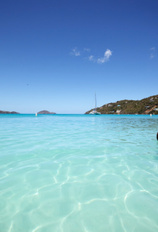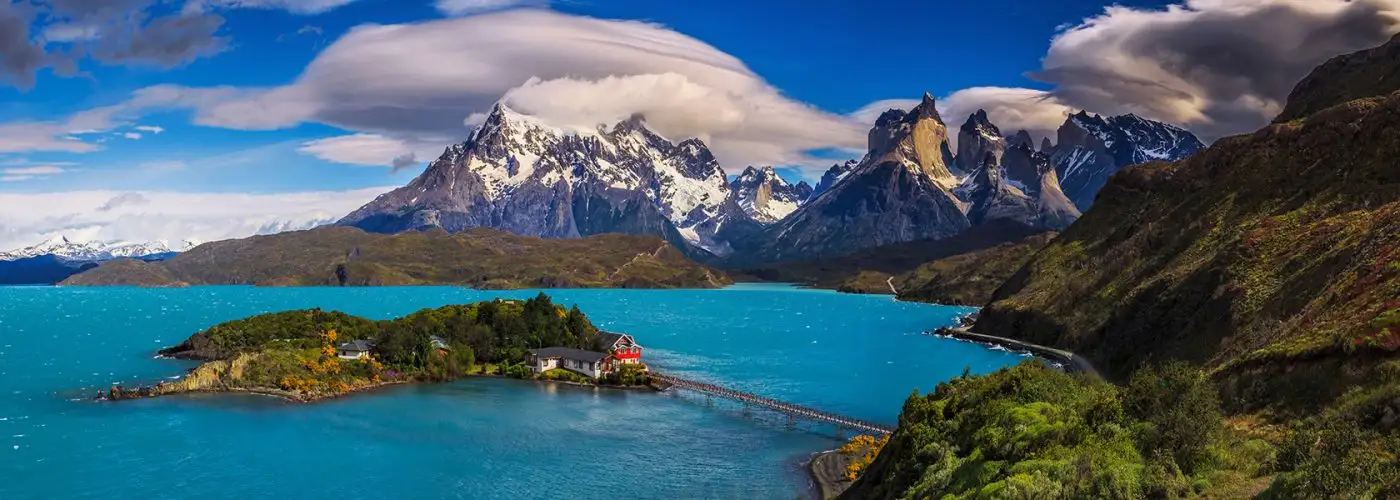If you’re yearning to cross Patagonia off your bucket list, do it during the southern hemisphere’s winter months—because Chile’s famed Torres del Paine national park is even better when the weather changes.
I will admit to a moment of doubt when I arrived at the end of the world. I’d come for a week of hiking and horseback riding in Chile’s famed Torres del Paine national park at the southernmost tip of South America, but if the snowstorm that greeted me was any indication then it didn’t look like nature and I had the same vacation plans.
The white-knuckle transfer from the airport in Punta Arenas to the remote explora Patagonia lodge inside Torres del Paine—five hours by van in whiteout conditions—did not exactly put my mind at ease, either. Three inches of thick, wet snow reduced the mostly dirt road to a single lane. Forests of stunted, waist-high trees watched me like snow-encrusted scarecrows from either side. And well-intentioned signs welcoming me to el fin del mundo, the end of the world, were blasted over with snow—more like a warning than an invitation.
Patagonia, I think, likes to reveal itself in fits and gasps during these short winter days. The sun rises after breakfast, and heavy clouds often linger through the morning, playing coy with your view of the granite peaks that give Torres del Paine its name. But then the weather lifts and it’s clear and sunny and you can see for miles, literally to the ends of the earth, and it’s like looking at the world through an Instagram filter: all rich colors, sharp contrasts, and peculiar shadows. You wouldn’t believe it was #nofilter unless you saw it with your own eyes.
After that first day, it didn’t snow again during my week in Torres del Paine. The national park, cut off from the rest of the Americas by mountains, ice fields, and the ocean, has a surprisingly temperate microclimate that leads to average temperatures in the high 50s, even in the winter. That explains why the blizzard in Punta Arenas gave way to lazy snowflakes inside the national park, and why my stay—in the middle of June, the heart of the South American winter—was actually the perfect time to hike in Torres del Paine.
The Towers of Pain
The explora Patagonia lodge sits on the shores of blue-green Lake Pehoe, smack in the middle of Torres del Paine, and it’s uniquely positioned for panoramic views of the three distinctive granite horns, or towers, that have become synonymous with the park. Looking at them from the hotel room window feels a bit like having your own private IMAX screen—it’s so hyper-real that it almost feels like a special effect. And it’s so inviting that you know you’re going to have to see them up close before your trip ends.
Explora Patagonia offers 50 guided explorations on foot and horseback to the remotest areas inside Torres del Paine. Three days into my stay, I’d already logged 45 miles of hiking through elbow-high grass and along steep, rutted horse paths; I’d listened to avalanches rumbling at intervals in the distant French valley; and I’d seen everything from a lagoon full of blue-white icebergs to old-growth forests of lenga, beech, and nirre trees. I’d spotted puma tracks in the fresh snow, listened to the chirrupy calls of astral parakeets, and followed a condor as it swooped above the granite peaks. I’d gotten close enough to snap close-ups of guanacos (a relative of the llama), torrent ducks (like salmon, they swim upstream), and a handful of Patagonian hares.
The only thing I hadn’t seen? Other tourists.
I mean that literally. There were a handful of guests staying at explora Patagonia—I’d put the guest-to-guide ratio at roughly one-to-one—but aside from them, I went days without seeing another human being on the trails. That stayed largely true even when the weather allowed me to make the strenuous hike to the base of the towers. The full-day hike takes you over rocks and rivers and, in the upper elevations, over snow and ice, too. (Torres del Paine does not, in fact, translate to “towers of pain,” but you could be forgiven for thinking that somewhere around hour seven or eight of the relentless 11-mile climb.) Yet for all the effort involved, it’s also the most popular excursion in the entire park.
“It’s like Times Square here in the summer,” said Matias Garcesz, one of my two bilingual Explora guides on the expedition.
“In the high season, there’s a line of people from top to bottom on this trail, and hundreds of buses at the trailhead,” echoed Tim Connelly, my other guide.
I didn’t see any buses at the trailhead in June, though. And I saw almost as many pumas (four) as I did other hikers (five) over the course of the 10-hour trek.
Torres del Paine is well known for its strong winds. No other landmass in the world shares its latitude, so there’s nothing to slow down the wind as it whips around the globe. In the summer high season, wind gusts of up to 124 miles per hour rip through the park’s higher altitudes. The winds are, surprisingly, much milder in the winter off-season. It felt like a light breeze even at the height of the trail.
I usually reserve my enthusiasm for winter to all things Game of Thrones, but here in Patagonia it’s abundantly clear that “winter is coming” is actually pretty good news.
The Explora Experience
It’s easy to see why explora is a three-time World Travel Award winner as South America’s leading expedition company. Explora, which has similar lodges in the Atacama Desert, Peru’s Sacred Valley, and on Rapa Nui, or Easter Island, runs in-depth small-group explorations of remote areas while embracing a philosophy that it describes as “the luxury of the essential.”
It’s upscale but rugged. It’s architecturally dramatic, but sustainably built and operated. It’s pricey, but it offers the once-in-a-lifetime kind of experience that justifies a bucket-list level splurge. A stay at explora Patagonia includes airport or hotel transfers from Punta Arenas; spacious rooms; all guided explorations; all meals and bar drinks; Wi-Fi access; national park entrance fees; optional evening lectures on topics like glaciology, ecology, native peoples, pumas, and ornithology; and access to indoor and outdoor spa facilities on the shores of Lake Pahoe.
Explora Patagonia is one of the few places to stay inside the park during winter. Puerto Natales, the closest town with lodging outside Torres del Paine, is a bumpy two-hour drive away. Explora Patagonia has 49 guest rooms and a maximum capacity of around 100 guests. There were only a handful of guests in the lodge on any given day when I stayed in June, which made it feel like my own private retreat. Before long, I knew each of the guests by name, and people who began as strangers were welcome dinner companions after hours together on the trails.
Explora Patagonia attracts visitors from all corners of the world: I met travelers from Singapore, Australia, Turkey, Lebanon, Ghana, and British Columbia during my stay.
The Gaucho Connection
Explora Patagonia isn’t just tied to the land—it’s also deeply connected to the local gaucho (or cowboy) culture. It’s the only lodge allowed to offer horseback riding excursions within Torres del Paine. The horses—a mix of Patagonian, Arabian, and English breeds with names like Aladdin and Diablo—are well-suited to both advanced and beginner riders. Each is trained for three years before going to either explora Patagonia or the explora lodge in the Atacama Desert, where horses undergo three additional months of familiarization with the landscape and weather conditions before they’re introduced to tourists. Horses are selected for each rider based on individual skills and comfort level—as are the outings, which range from beginner half-day rides to epic excursions into hard-to-reach wilderness areas.
“Personally, I think some of the best experiences we offer at explora are the full-day advanced horse riding,” Connelly told me. “We go to places that are remote and beautiful and that you simply can’t get to on foot; through swamps, across rivers, with views that are unbeatable and totally isolated. One moment you’ll look up and there will be packs of wild horses and cows roaming the land ahead of you.”
I’m more comfortable in my hiking boots than in the saddle, so I stuck with the beginner-level rides. The post-ride experience is the same either way: Guests are invited to drink mate (a bitter, grassy concoction, tea like and rich in caffeine) with the ranch gauchos afterward. Gauchos drink mate for 30 to 60 minutes every morning, then work for hours before having breakfast. The drink’s roots lie with the indigenous Patagonian tribes, who drank it long before the first Europeans arrived.
Getting There
From the U.S., most travelers will fly to Chile’s Santiago International Airport. I used LAN Airlines, which operates flights from Santiago to Punta Arenas. Depending on your arrival time, explora Patagonia will either arrange to pick you up directly from the airport or from a nearby hotel the following morning. Return transfers are handled the same way, often allowing you to hike or ride after breakfast before hopping into an explora van for the long ride back to civilization.
When you’ve reached the edge of the world, there’s no place left to go but home.
More from SmarterTravel:
- Walking the Great Wall of China: A Bucket List Trip You Can Afford
- A Wild Kingdom in the Clouds: Inside Ecuador’s Mashpi Lodge
- 10 Best Adventure Travel Trips of 2015
SmarterTravel’s Managing Editor Josh Roberts traveled to Torres del Paine national park as a guest of Explora Patagonia, which sponsored his trip. Follow him on Instagram @jauntist.
We hand-pick everything we recommend and select items through testing and reviews. Some products are sent to us free of charge with no incentive to offer a favorable review. We offer our unbiased opinions and do not accept compensation to review products. All items are in stock and prices are accurate at the time of publication. If you buy something through our links, we may earn a commission.
Related
Top Fares From
Today's Top Travel Deals
Brought to you by ShermansTravel
Kenya: 14-Night Tour, Incl. Tanzania &...
smarTours
 vacation
$7125+
vacation
$7125+
7-Night Caribbean Round-Trip Cruise From Orlando:...
Norwegian Cruise Line
 cruise
$739+
cruise
$739+
Ohio: Daily Car Rentals from Cincinnati
85OFF.com
 Car Rental
$19+
Car Rental
$19+




